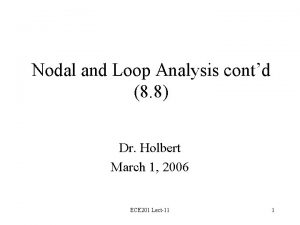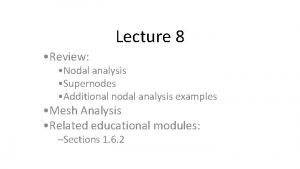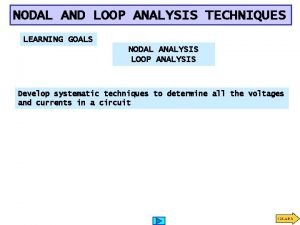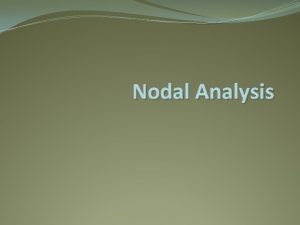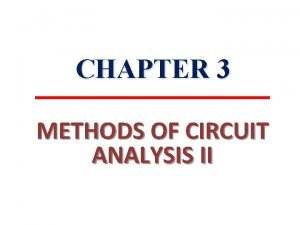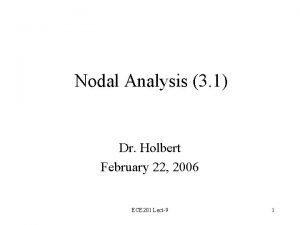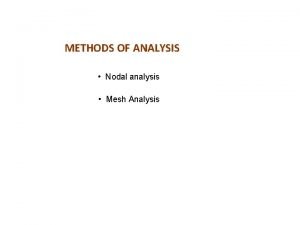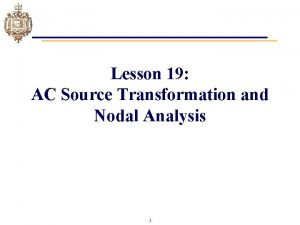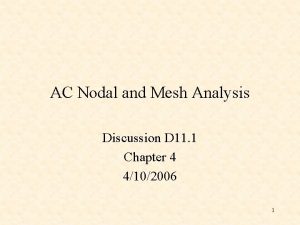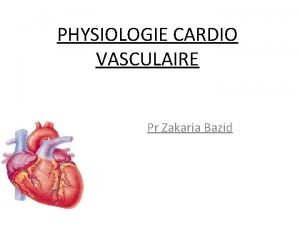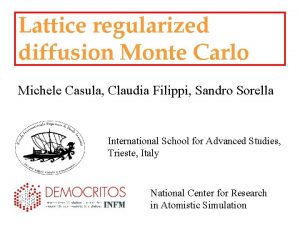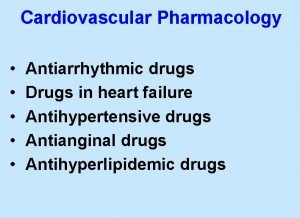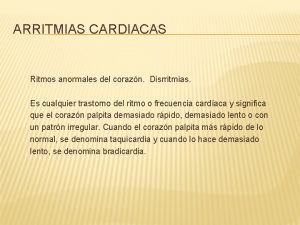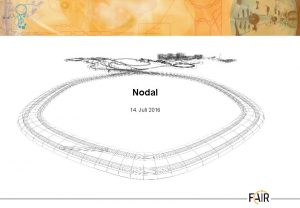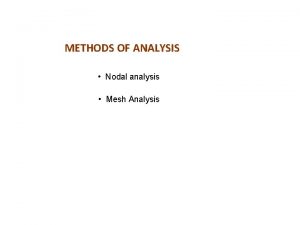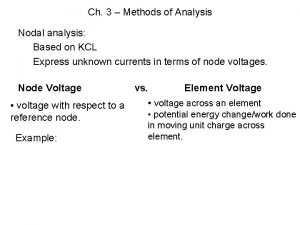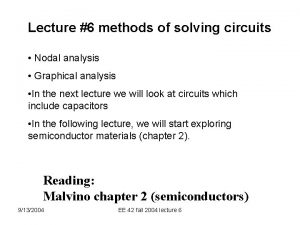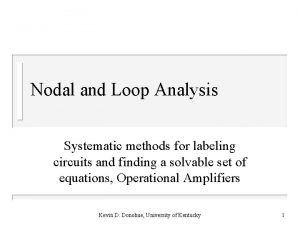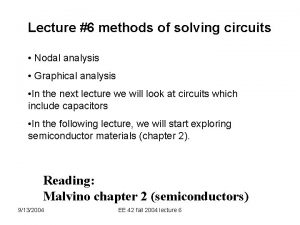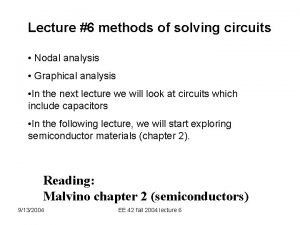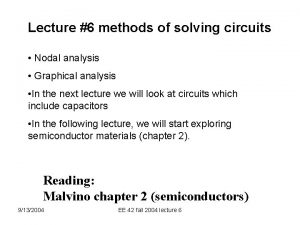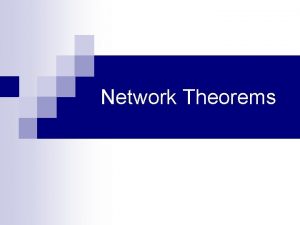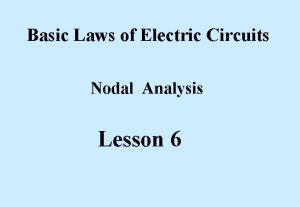Nodal Analysis 1 Methods of Analysis Introduction Nodal


















- Slides: 18

Nodal Analysis 1

Methods of Analysis • Introduction • Nodal analysis with voltage source 2

Steps of Nodal Analysis 1. Choose a reference (ground) node. 2. Assign node voltages to the other nodes. 3. Apply KCL to each node other than the reference node; express currents in terms of node voltages. 4. Solve the resulting system of linear equations for the nodal voltages. Common symbols for indicating a reference node, (a) common ground, (b) ground, (c) chassis. 3

1. Reference Node 500 W + I 1 500 W V 1 k. W 500 W I 2 – The reference node is called the ground node where V =0 4

Steps of Nodal Analysis 1. Choose a reference (ground) node. 2. Assign node voltages to the other nodes. 3. Apply KCL to each node other than the reference node; express currents in terms of node voltages. 4. Solve the resulting system of linear equations for the nodal voltages. V 1 500 W V 500 W 2 1 I 1 2 500 W V 3 3 1 k. W 500 W I 2 V 1, V 2, and V 3 are unknowns for which we solve using KCL 5

Steps of Nodal Analysis 1. Choose a reference (ground) node. 2. Assign node voltages to the other nodes. 3. Apply KCL to each node other than the reference node; express currents in terms of node voltages. 4. Solve the resulting system of linear equations for the nodal voltages. Currents and Node Voltages V 1 500 W V 2 V 1 500 W 6

3. KCL at Node 1 V 1 I 1 500 W V 2 500 W 7

3. KCL at Node 2 V 1 500 W V 2 500 W V 3 1 k. W 8

3. KCL at Node 3 V 2 500 W V 3 500 W I 2 9

Steps 1. of. Choose Nodal Analysis a reference (ground) node. 2. Assign node voltages to the other nodes. 3. Apply KCL to each node other than the reference node; express currents in terms of node voltages. 4. Solve the resulting system of linear equations for the nodal voltages. 500 W Solution: V = 167 I 1 + 167 I 2 + I 1 500 W V 1 k. W – 500 W I 2 10

Practice the following : (Lb. D) • Determine the voltage at the nodes in Fig. below At node 1, At node 2, At node 3, 11

• In matrix form: 12

Nodal Analysis with Voltage Sources • Case 1: The voltage source is connected between a nonreference node and the reference node: The nonreference node voltage is equal to the magnitude of voltage source and the number of unknown nonreference nodes is reduced by one. • Case 2: The voltage source is connected between two nonreferenced nodes: a generalized node (supernode) is formed. 13

Nodal Analysis with Voltage Sources A circuit with a supernode. 14

• A supernode is formed by enclosing a (dependent or independent) voltage source connected between two nonreference nodes and any elements connected in parallel with it. • The required two equations for regulating the two nonreference node voltages are obtained by the KCL of the supernode and the relationship of node voltages due to the voltage source. 15

Example • For the circuit shown in Fig. , find the node voltages. i 1 i 2 16

Find the node voltages in the circuit below. • At supernode 1 -2, At supernode 3 -4 17

Summary 1. Nodal analysis: the application of KCL at the nonreference nodes • A circuit has fewer node equations 2. A supernode: two nonreference nodes
 Advantages of nodal analysis
Advantages of nodal analysis Definition of supernode
Definition of supernode Supernode
Supernode Nodal analysis steps
Nodal analysis steps Nodal analysis
Nodal analysis Nodal analysis
Nodal analysis Nodal analysis
Nodal analysis Process transformation
Process transformation Nodal analysis
Nodal analysis Find vo using mesh analysis
Find vo using mesh analysis Ac mesh analysis
Ac mesh analysis Direct wax pattern
Direct wax pattern Tissu nodal localisation
Tissu nodal localisation Myoplasme
Myoplasme Cur 1
Cur 1 Michele casula
Michele casula Lineas antinodales
Lineas antinodales Cardiomyocyte action potential
Cardiomyocyte action potential Arritmia sinusal con cvp
Arritmia sinusal con cvp
